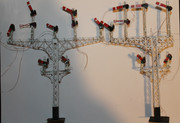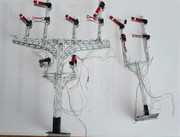Bournahempton [1936 - Southern Railway - 00 - automated]
Re: Bournahempton [1936 - Southern Railway - 00 - automated]
You are a brave soul. Ballast is tricky business, particularly with points, of which Bournahempton has a wealth.
- jamespetts
- Posts: 70
- Joined: Fri Apr 15, 2022 10:30 pm
- Contact:
Re: Bournahempton [1936 - Southern Railway - 00 - automated]
It has to be done at some point! But there is less risk of jamming the mechanism ballasting in this way than in the more conventional fashion.
- jamespetts
- Posts: 70
- Joined: Fri Apr 15, 2022 10:30 pm
- Contact:
Re: Bournahempton [1936 - Southern Railway - 00 - automated]
I see that I have not posted here in a long time!
Work on this is coming on very slowly. I was substantially delayed at the beginning of the year because of building works in my house which have carried on far longer than were anticipated and are still not fully complete. I have made some progress, however.
 Length testing for engine shed by James Petts, on Flickr
Length testing for engine shed by James Petts, on Flickr
 Baseboards by James Petts, on Flickr
Baseboards by James Petts, on Flickr
One thing that has taken a particularly long time is working out how to cut inspection pits and then actually inserting them. I ended up purchasing laser cut inspection pit kits and then I had to buy a jigsaw (and then another jigsaw, as the first was not strong enough) actually to cut them, then work out how to fix them in place, fill the gaps around the edges, then lay track on top of them.
 Inspection pits installed by James Petts, on Flickr
Inspection pits installed by James Petts, on Flickr
 Inspection pit progress by James Petts, on Flickr
Inspection pit progress by James Petts, on Flickr
 Inspection pits by James Petts, on Flickr
Inspection pits by James Petts, on Flickr
I think that I have now largely finished the actual track laying in the inspection/ash pits (as of yesterday), but ancillary work (such as filling in the track inside the engine sheds) has yet to be completed, and I am not sure yet quite how best to do this. As a temporary expedient, I have painted the sleeper stubs the same concrete colour as the base.
In the meantime, the person from whom I had ordered signals about this time last year is working on them and has sent me pictures of their progress:



They look very good so far - apparently the delay is due to some difficulties in building the ground signals to a working standard.
I take the view that the signals are at least half the fun of a layout, so I think that I will have to build a virtual lever frame to allow an operator to take on the role of signaller while the trains run themselves.
Work on this is coming on very slowly. I was substantially delayed at the beginning of the year because of building works in my house which have carried on far longer than were anticipated and are still not fully complete. I have made some progress, however.
 Length testing for engine shed by James Petts, on Flickr
Length testing for engine shed by James Petts, on Flickr Baseboards by James Petts, on Flickr
Baseboards by James Petts, on FlickrOne thing that has taken a particularly long time is working out how to cut inspection pits and then actually inserting them. I ended up purchasing laser cut inspection pit kits and then I had to buy a jigsaw (and then another jigsaw, as the first was not strong enough) actually to cut them, then work out how to fix them in place, fill the gaps around the edges, then lay track on top of them.
 Inspection pits installed by James Petts, on Flickr
Inspection pits installed by James Petts, on Flickr Inspection pit progress by James Petts, on Flickr
Inspection pit progress by James Petts, on Flickr Inspection pits by James Petts, on Flickr
Inspection pits by James Petts, on FlickrI think that I have now largely finished the actual track laying in the inspection/ash pits (as of yesterday), but ancillary work (such as filling in the track inside the engine sheds) has yet to be completed, and I am not sure yet quite how best to do this. As a temporary expedient, I have painted the sleeper stubs the same concrete colour as the base.
In the meantime, the person from whom I had ordered signals about this time last year is working on them and has sent me pictures of their progress:



They look very good so far - apparently the delay is due to some difficulties in building the ground signals to a working standard.
I take the view that the signals are at least half the fun of a layout, so I think that I will have to build a virtual lever frame to allow an operator to take on the role of signaller while the trains run themselves.
-
cheshire lines
- Posts: 396
- Joined: Tue Oct 09, 2018 4:40 pm
- Contact:
Re: Bournahempton [1936 - Southern Railway - 00 - automated]
Interesting photos showing good progress.
Just curious, what did you use to mark out the track plan prior to tracklaying?
Just curious, what did you use to mark out the track plan prior to tracklaying?
- jamespetts
- Posts: 70
- Joined: Fri Apr 15, 2022 10:30 pm
- Contact:
Re: Bournahempton [1936 - Southern Railway - 00 - automated]
The people who made the baseboards managed to print this onto the baseboards from SCARM using a special printer. This is, apparently, the first time that they have done this, and it is quite an innovation, I think.cheshire lines wrote: ↑Wed Nov 13, 2024 4:14 pm Interesting photos showing good progress.
Just curious, what did you use to mark out the track plan prior to tracklaying?
-
cheshire lines
- Posts: 396
- Joined: Tue Oct 09, 2018 4:40 pm
- Contact:
- bulleidboy
- Posts: 2310
- Joined: Thu Oct 04, 2018 6:30 pm
- Location: Basingstoke, Hants
- Contact:
Re: Bournahempton [1936 - Southern Railway - 00 - automated]
Good progress James. I think I would have used Peco Inspections pits - they come with either Codee 100 or 75 track, and would have saved you carving up the sleepers - I appreciate once "concreted" in place, they look as they should.
- jamespetts
- Posts: 70
- Joined: Fri Apr 15, 2022 10:30 pm
- Contact:
Re: Bournahempton [1936 - Southern Railway - 00 - automated]
Yes, in retrospect, that may have been easier!bulleidboy wrote: ↑Wed Nov 13, 2024 11:34 pm Good progress James. I think I would have used Peco Inspections pits - they come with either Codee 100 or 75 track, and would have saved you carving up the sleepers - I appreciate once "concreted" in place, they look as they should.
Who is online
Users browsing this forum: No registered users and 1 guest